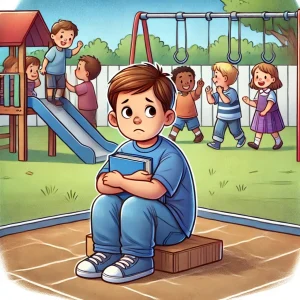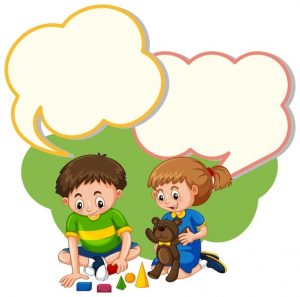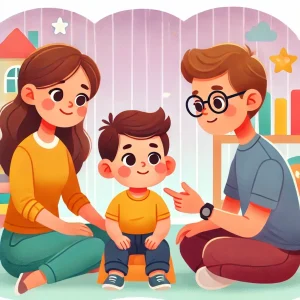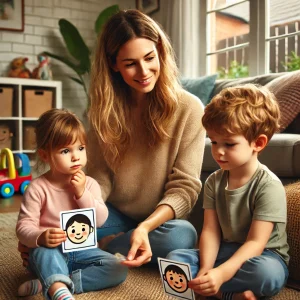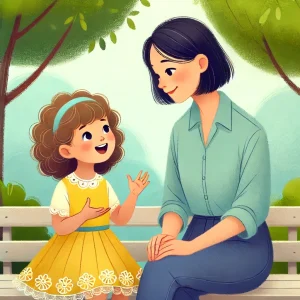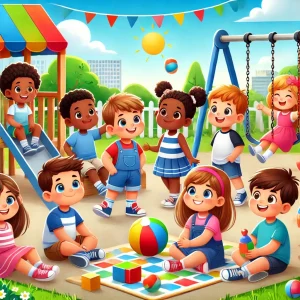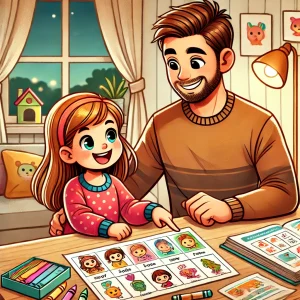Help Your Little One Perfect the ‘CH’ Sound: Expert Tips and Tricks
By Rajini D
Last Updated: April 18, 2024
Have you ever found yourself endlessly repeating the word “cheese” just to capture a moment of your child’s perfect smile, only to notice they struggle to pronounce that tricky “CH” sound correctly? You’re not alone. Mastering the “CH” sound is a common hurdle for many children as they develop their speech and language skills. This sound requires a precise combination of tongue placement, breath control, and timing—no small feat for a young learner!
Why is the “CH” sound so important, you ask? Well, beyond the obvious joy of ordering a “chocolate chip cheesecake” flawlessly, the ability to articulate this sound plays a crucial role in clear and effective communication. Mispronunciations can lead to misunderstandings or a lack of confidence in social settings, especially as children begin to compare their speech abilities to those of their peers.
Also Read: Speech Therapy Strategies for Kids: Mastering CH Words
Understanding the ‘CH’ Sound
Let’s get straight to it and talk about the “CH” sound. This sound pops up in lots of words like “chocolate,” “cheese,” and “cherry.” To make the “CH” sound, kids learn a special tongue and breath move. Here’s how it goes: the tip of the tongue taps just behind the top front teeth, the teeth gently touch, and then, when the tongue moves back, air whooshes out. That’s how we get the “CH” sound.
Imagine you’re trying to say “chicken” or “choose.” The initial position of your tongue and the sudden release of air are what make the “CH” sound distinct from others. It’s this unique blend of touch and go, a quick, controlled burst of breath through the mouth, that brings the “CH” sound to life.
Also read: Help Kids Master the “CH” Sound
When Should Kids Master the “CH” Sound?
You might be asking, “When should my child be able to say the ‘CH’ sound right?” Good question! Usually, kids start saying the “CH” sound correctly when they’re about 3.5 to 4 years old. But it’s also okay if some kids take a bit longer, like until they’re 6 to 7 years old. Every kid is different and grows at their own speed. When it comes to talking and making sounds, there’s a big range of what’s normal. So, there’s a lot of space for each kid to be different.
Age Milestones for ‘CH’ Sound Mastery
| Age Range | Milestone Achievement |
|---|---|
| 3.5 – 4 years | Beginning to articulate the ‘CH’ sound. This is the initial stage where children start experimenting with the sound, often inconsistently, as they explore and learn its mechanics. |
| 5 – 6 years | Consistently using the ‘CH’ sound in words. By this age, children are expected to produce the ‘CH’ sound more reliably in everyday speech, showing that they’ve begun to master the sound’s production. |
| 7 years and older | Mastering the ‘CH’ sound with clarity. Children at this stage can articulate the ‘CH’ sound clearly and correctly in various words and contexts, indicating a strong grasp of the sound. |
Also Read: Help Kids Master the “TH” Sound: Fun & Easy Tips
Signs Your Child Might Need Extra Help
As parents, we all wish for our children’s paths to be as smooth and joyous as possible. But sometimes, they might need a bit of extra help, and that’s perfectly okay. When it comes to mastering the “CH” sound, there are a few signs you can look out for that might indicate your child could benefit from additional support. Recognizing these signs early on can make a significant difference in their speech development journey.
Here’s what to keep an eye on:
- Considering the age: By 3.5 to 4 years old, most kids start saying the “CH” sounds right. If your child is way past this age and still having trouble, it might be time to look for more help.
- Inconsistent sounds: If your child says the “CH” sound right sometimes but not all the time, or if they’re not consistent, this means they might not have fully got the hang of making this sound.
- Avoiding “CH” words: Kids know when something’s hard. If they avoid words with the “CH” sound, they’re probably finding those words hard.
- Feeling frustrated or trying again and again: Watch for signs of getting upset or trying many times to say “CH” sound words right. This shows they know it’s hard but can’t quite get it yet.
- What teachers say: Sometimes, teachers or daycare workers spot speech things that could use more help. What they notice can be really helpful, showing stuff that might not be so clear at home.
Expert Tips and Tricks for Practice
Now that we’ve discussed the importance of the “CH” sound and how to recognize if your child might need some extra help, let’s dive into some fun and effective ways to practice. These strategies are designed to make learning enjoyable and to fit seamlessly into your daily routine.
Visual Demonstrations
- The Sneeze Technique: Children love to mimic adults, especially when it involves making funny sounds or faces. Introduce the “CH” sound with the “sneeze technique.” Pretend to sneeze using an exaggerated “Ahhh-CHOO!” Make sure to emphasize the “CH” part. It’s fun, and it visually and audibly demonstrates how the sound is made.
- Facial Expressions Game: Play a game where you both make different facial expressions to mimic the “CH” sound’s production. Exaggerate the rounding of your lips and the burst of air. This not only helps with sound production but also turns practice into a hilarious activity.
Verbal Games and Exercises
- Tongue Twisters: Create simple tongue twisters that use the “CH” sound repeatedly. For example, “Charlie chooses the cheesiest cheese.” Start slowly and gradually increase the speed as your child becomes more comfortable with the sound.
- The “It’s You” Game: This game helps transition from the “T” and “SH” sounds to the “CH” sound. Say “it’s you” slowly at first, then more quickly, until it starts sounding like “CH.” It’s a simple yet effective way to practice the sound in a playful context.
Engaging Activities
- CH Sound Scavenger Hunt: Turn practice into an adventure with a scavenger hunt for items around the house that start with the “CH” sound. This activity helps reinforce the sound and builds vocabulary at the same time.
- Crafts with CH: Engage in crafts that revolve around things starting with “CH.” Whether it’s making a paper chain, a cheerful chameleon, or a charming church, crafting provides a hands-on way to reinforce the sound.
- Cooking Up ‘CH’ Words: Involve your child in cooking or baking activities that involve “CH” words, like cheese, chocolate, or chicken. As you cook, emphasize the “CH” sound, turning the kitchen into a classroom.
Integrating the “CH” Sound into Daily Life
After laying a solid foundation through playful practice and expert strategies, the next step is weaving the “CH” sound into the fabric of daily life. This transition from isolated sounds to natural speech is crucial for long-term success and confidence in communication. Here are strategies to seamlessly integrate the “CH” sound into more complex speech patterns, ensuring that practice feels like an organic part of your child’s day.
Embedding “CH” in Everyday Communication
- Talk About Your Day: Use “CH” sound words when you talk about what you’re doing or planning. Like asking, “Do you want a chocolate chip cookie or a piece of cheese?” This helps your child hear and practice the “CH” sound when talking normally.
- MakeUp Stories: Together, come up with stories that have lots of “CH” words. It could be about a cheeky cheetah or a friendly chair. Making up stories is a fun way to practice the “CH” sound. Let your child tell their stories, using “CH” words a lot, to get better and more confident at it.
Making Practice a Natural Part of the Day
- Incorporate into Routines: Find moments within your daily routine to practice the “CH” sound. For example, while choosing clothes for the day or checking off chores from a list, emphasize “CH” words. This repetition in a familiar context helps reinforce learning.
- Positive Reinforcement: Celebrate successes, no matter how small. Acknowledging correct pronunciation with a high five or a sticker can motivate continued effort. Focus on communication as a whole, rather than correcting every mispronunciation, to build confidence.
- Interactive Learning Opportunities: Encourage activities that naturally contain “CH” sounds, like cooking or crafting. “Let’s chop carrots” or “Let’s attach this piece here.” These interactive experiences provide a hands-on approach to practice while accomplishing everyday tasks.
Read more on our article: Improve Speech at Home: Easy Exercises & Fun Activities.
When to Seek Professional Help
As we navigate the path of supporting our children’s speech development, there comes a point where we might wonder if professional help is needed. Knowing when to seek the expertise of a speech-language pathologist (SLP) can make a significant difference in your child’s progress.
Here are signs that it might be time to consult a professional:
- If your child is much older than the usual age for getting the “CH” sound right (about 3.5 to 7 years) and still has trouble, it might be time to talk to an SLP.
- Feeling upset or not wanting to talk: Watch if your child gets upset or doesn’t want to talk because of trouble with the “CH” sound or other speech sounds. When it affects their feelings or social life, they might need help from a pro.
- Hard time making words or sentences: Trouble that’s not just with the “CH” sound but also making other words or sentences clear might mean bigger speech learning challenges.
- What teachers or others say: Sometimes, teachers or other people taking care of your kid might notice speech things or milestones that need a closer look. What they see can be really helpful.
- No getting better: If, even with lots of practice and help at home, there’s not much change over a long time, a speech therapist can check things out and offer special tips to help your child improve.
How Wellness Hub Can Support You
Recognizing these signs and deciding to seek professional help is a proactive step toward supporting your child’s speech development. At Wellness Hub, we understand the importance of this decision. While we offer a plethora of resources to support parents and caregivers on this journey, we also recognize the invaluable role of specialized professional support when needed.
Our platform can serve as your starting point for finding expert advice and support. While Wellness Hub itself is a hub of information and guidance, we encourage you to use our resources as a supplement to, not a replacement for, professional evaluation and therapy if required.
Encouragement and Support: The Role of Caregivers
The Power of Positive Reinforcement
- Celebrate Small Wins: Every attempt, not just the correct ones, is a step forward. Celebrate the effort as much as the outcome. This could be as simple as a high five, a sticker, or a verbal acknowledgment of their hard work.
- Use Encouraging Language: Instead of saying, “No, that’s not right,” try framing feedback positively. “You’re so close! Let’s try that one more time together.”
- Visual Progress Charts: Create a fun progress chart where your child can add a sticker for each practice session or each time they correctly use the “CH” sound. Seeing their progress visually can be a great motivator.
Keeping the Learning Process Engaging
- Incorporate Interests: Use your child’s interests to make practice sessions more engaging. If they love animals, practice “CH” words like “cheetah” or “chinchilla.” Tailoring sessions to their interests can keep them intrigued and willing to participate.
- Switch Roles: Let your child be the teacher, correcting your intentional mistakes. This not only makes learning fun but also boosts their confidence as they get to “teach” you the correct sounds.
- Create a Routine: Incorporate practice into daily routines in a non-intrusive way. Whether it’s during mealtime, bath time, or while getting dressed, using “CH” words during these activities can make practice feel like a natural part of their day.
Fostering a Supportive Environment
- Patience is Key: Remember, learning takes time. Show patience and understanding, reinforcing that it’s okay to make mistakes. Your calm presence makes learning a pressure-free experience for your child.
- Open Communication: Encourage your child to express how they feel about their progress and any frustrations they might have. Open communication fosters trust and lets them know it’s okay to share their feelings with you.
- Seek Support When Needed: If you find yourself facing persistent challenges, remember that it’s okay to seek help. Wellness Hub and professionals like speech-language pathologists are here to support you and your child through this journey.
Conclusion
As we wrap up our guide on helping your child with the “CH” sound, let’s remember the main points. Mastering this sound is a big step that helps your child communicate better and feel more confident. We’ve covered how to make the “CH” sound, signs that might show your child needs extra help, and fun ways to practice. Remember, every child learns at their own pace, and your support and encouragement are key. Celebrating every effort and keeping learning fun will go a long way in your child’s progress.
We’d love to hear from you—sharing your experiences and tips can help other parents. At Wellness Hub, we’re here to support you with resources for all kinds of developmental milestones. With the right approach and a supportive community, mastering the “CH” sound is definitely within reach. Thanks for reading, and let’s keep supporting each other in helping our kids speak clearly and confidently.
Frequently Asked Questions:
1. What age should a child pronounce the “CH” sound correctly?
Children typically start to pronounce the “CH” sound correctly between 3.5 and 7 years old. This developmental milestone can vary widely as each child grows and learns at their own pace. If a child is struggling with this sound past the age of 7, it may be beneficial to consult a speech-language pathologist for personalized guidance and support.
2. How can I help my child learn the “CH” sound at home?
Teaching your child the “CH” sound at home can be fun and work well if you use the right activities. Try things like pretending to sneeze, making up stories with lots of “CH” words, and playing with tongue twisters. Doing these fun activities every day and giving lots of cheers and thumbs up will help your child get really good at making the “CH” sound.
3. What are signs that my child might need extra help with the “CH” sound?
If your child has trouble with the “CH” sound after they’re 7, avoids saying words with this sound, seems upset or doesn’t want to talk much, or doesn’t get better at it even with lots of practice, these could be signs they need extra help. Noticing these signs early and asking a professional for advice can really help your child get better at making the “CH” sound.
4. Can games really help my child master the “CH” sound?
Yes, games and interactive activities are highly effective in speech development, including mastering the “CH” sound. Games engage children’s attention and interest, making practice feel less like work and more like play. This not only enhances the learning experience but also encourages frequent practice, which is crucial for improvement.
5. When should I consider professional help for my child’s “CH” sound pronunciation?
Professional help should be considered if your child is showing persistent difficulty with the “CH” sound beyond the expected age range, if there’s significant frustration related to speaking, or if progress stalls despite consistent practice at home. A speech-language pathologist can assess your child’s needs and provide tailored strategies and support for improvement.
6. How does positive reinforcement help in speech development?
Positive reinforcement plays a crucial role in speech development by motivating and building confidence in children as they learn new sounds. Acknowledging every effort, celebrating small victories, and maintaining a supportive and encouraging environment help children feel successful and encourage them to keep practicing and improving.
7. What resources does Wellness Hub offer for speech development?
Wellness Hub offers a comprehensive suite of resources aimed at supporting speech development, including expert-written articles, practical tips, and community-shared experiences. These resources are designed to help parents and caregivers find the information and support they need to guide their children through their speech development journey successfully.
8. How long does it typically take for a child to master the “CH” sound?
The time it takes to master the “CH” sound can vary. Most children achieve it between 3.5 and 7 years, but individual progress depends on consistency of practice and the child’s unique developmental pace.
9. Are there any tools or apps recommended for practicing the “CH” sound?
Yes, tools like Speech Buddies and educational apps designed for speech development can be effective. They offer interactive ways to practice and reinforce the “CH” sound in engaging and fun contexts.
10. How can I make practicing the “CH” sound more engaging for my child?
Incorporating the child’s interests into practice, using games, songs, and stories featuring “CH” sounds, and turning practice sessions into playful, creative activities can make learning much more engaging.
About the Author:
Rajini Darugupally
M.Sc., Speech-Language Pathologist (9+ years of experience)
Rajini is a passionate and dedicated Speech-Language Pathologist with over 9+ years of experience, specializing in both developmental speech and language disorders in children and rehabilitation in adults. Driven by a desire to empower each individual to find their voice, Rajini brings a wealth of experience and a warm, genuine approach to therapy.
Currently, at Wellness Hub, she thrives in a team environment that values innovation, compassion, and achieving results for their clients.
Connect with Rajini to learn more about how she can help you or your loved one find their voice.
Book your Free Consultation Today
Parent/Caregiver Info:
Client’s Details:
* Error Message
